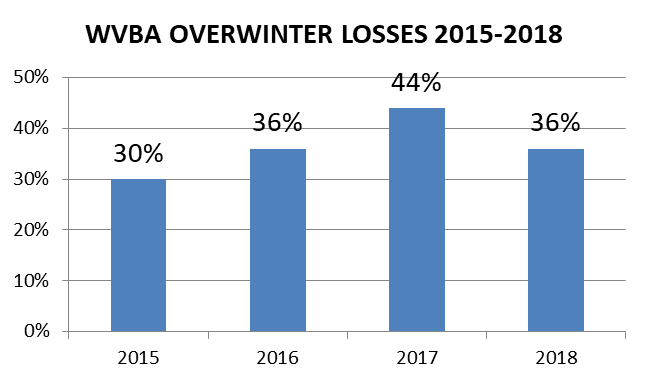In the 2017-2018 beekeeping season, 303 Oregon & 104 Washington backyarder beekeepers participated in the April survey that measures the health of our regions honey bee colonies. The survey tool also measures the local honey bees survival/losses with the highly diverse management variables such as the feeding, sanitation and Varroa sampling/control of individual beekeepers! These large sets of annual data have been intriguing to analyze over the last five years and are all available to review at the state and individual club level on our website.
The online survey instrument www.pnwhoneybeesurvey.com/survey will be opened March 15 and extend through month of April. It should only take a few minutes to complete, especially if you are using the “note sheet”, found online under the resources tab. Information requested this year is similar to previous years, but I have trimmed the survey so it is shorter with fewer questions. I have paper copies for those who prefer this form over the electronic survey. I very much appreciate the 34 responses from WVBA Beekeepers last year.
Colony loss levels from all 304 OR respondents were 38%; of 1277 fall colonies 789 colonies survived to the spring). 89% were 8- and 10-frame Langstroth hives. For the 34 WVBA respondents, overall losses last spring were 36%, essentially the same as statewide losses but lower than the previous year. See the 4-year WVBA loss graph.
Not everyone had loss. Fourteen individuals (41%) reported total winter survival. Five individuals (15%) lost 100% of their colonies. Typical of the statewide data, WVBA respondents are largely new beekeepers and maintain few colonies. 17 individuals (50%) had 1, 2 or 3 years of experience. Four individuals (12%) had 10 years or more of bee experience, with the highest 34 years. 54% of WVBA respondents had 1, 2 or 3 colonies and another 20% had 4-6 colonies, 14% had 5 to 8 colonies and 4 had 10+ colonies, largest number was 12. Twenty-six individuals (53%) said they had a mentor available when they started keeping bees compared to 69% statewide.
While the main emphasis of the survey revolves around reporting how many colonies there were in last fall compared to this spring, which we assess three ways, through hive location, hive types and origination (meaning were they overwintered colonies, nucs or packages purchased, swarms or splits), other survey questions relate to some of the basic managements done for varroa control. In my annual report I show things that worked for some individuals. Feeding dry sugar, basic sanitation and providing colonies a distinct address helped some individuals keep loses lower. Monitoring for mites and the use of some controls also resulted in lower losses by Lane beekeepers. See website (under survey reports) www.pnwhoneybeesurvey.com for specific reports for WVBA membership.
The question is what will the climatic events of this year mixed with our ever-changing beekeeping practices result in this year? Only time and YOU will tell. Ramesh on NPR Feb 18th predicted heavy losses for a 3rd year in row. Eric Olsen, once the largest Washington beekeeper (Yakima area) said “their hives experienced a dramatic loss this year. But it’s not as bad as when he lost about 65 percent of them. https://www.npr.org/…/massive-loss-of-thousands-of-hives-afflicts-orchard-growers-and…
THANK YOU FOR SHARING THIS PAST SEASON. Please consider completing a survey for the 2018-2019 SEASON. It is my hope that the survey and reports have become a worthy asset in your beekeeping journey. I will have loss numbers within a month and the full report for WVBA by mid-summer.

